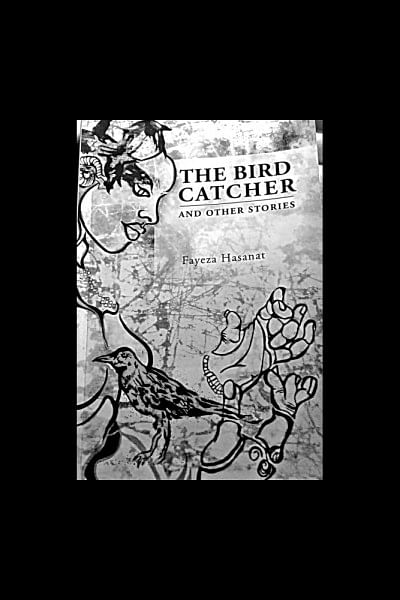Lore of the Woman: The Bird Catcher and Other Stories

A reader can perhaps assume from the back flap of Fayeza Hasanat's debut collection of short stories that the pieces revolve around a woman's position in society, familial relationships and identity that is constructed for her. But that is all one can assume because the stories presented here are no simple social representation of women's lives. They delve into the complex psyche of women who look into their souls and search for other identities beyond that of a wife, mother, daughter and sister. One might as well ask, "What makes a woman?"
Hasanat's The Bird Catcher and Other Stories is certainly not an easy read. A reader might pause to blink and think many a times between the two covers of the volume. A rhythmic story-telling punctured by searing language and literary allusions, this collection could very well be titled, The Lore of Bangladeshi Women, relating the tales of women who have stood on the threshold of nothingness.
The first story "The Anomalous Wife" might remind one of Charlotte Perkins Gilman's "The Yellow Wall-Paper." That the wife wants to walk into the sea after thirty years of marriage could also evoke Virginia Woolf who walked into a river. The piece is also a commentary on the limited and problematic aspects of counseling and the definition of mental health. The patient is wondering about her doctor, "What is wrong with this woman? Why is she so paradisally dumb?" One might also ask what the purpose of therapy is. Does it cure, or does it make one adept in a world that has gone terribly wrong? Hasanat surely questions the established norms of the society that deems a successful Bangladeshi man as the one "who has lived the American dream to the fullest, must have in his possession a few perfectly designed children and a content wife" (24).
"Bride of the Vanishing Sun" turns to an age-old problem in Bangladeshi society that judges the beauty of a woman through her skin colour. Konay dekha alo is a romantic term that suggests that the late afternoon light would make even a dark-skinned girl absorb some of the light of the setting sun. The reality, however, is indeed very different. The mother and grandmother of Aandhi may hope that the magical light would turn their darling into a beauty, but the groom and his family keep on weighing the prospective bride through dowry. The darker the skin colour, the higher the amount.
The incapability of men to appreciate their wives as human beings is an inherent theme of Fayeza Hasanat's collection. A woman is never a complete human being; even her loving father or brother fails to see her so, making one question the nature of love a woman is showered with. It is mostly another woman that can hear the anguish and is able offer some solace as can be seen in "Mother Immigrant" and "Make Me Your Sitar."
Noor Jahan—the old lady in "Mother Immigrant" is a relatively new kind of mother in contemporary society. She lives among her children in the US and mesmerizes her audience with her stories of wisdom and hope. Her definition of home is indeed one that any immigrant would recognize: "What home? Home is not where you are from. Home is where you live. Home is where your children and grandchildren are. Home is where you die. This is my home, because this is where I will die." (95). At the same time, this is also a thought-provoking portrayal of a system where elderly parents are ferried from one house to another. The only person who truly cares for Noor Jahan cannot claim her because she is her daughter-in law and certainly does not love her more than her own children. "Make Me Your Sitar" evokes a similar relationship from a village of the old times, where a mother-in-law chases out her son whose only understanding of marital pleasure is to rape his young bride.
"Darkling I Listen" portrays typical marriage in which the mother-in law screeches at her son's wife. The main focus of the story is the narrator, a woman who is judged for her incapacity to bear children. The definition of love then might very well become a practice of oppression: "There are no two beings in love: there's only one—the one who is stronger, the one who absorbs the other like a sponge eats the other like a flesh-eating bacteria" (109). And when the wife fails to fulfill her wifely duties, in this case, of bearing a child, the ardent husband says, "I am powerless. I can't hurt my parents." But isn't adoption a viable option for educated couples?
When a student writes to his teacher about his dying father, the narrator of "When Our Fathers Die" suddenly recalls the death of her own father—the pain, helplessness and some insignificant detail suddenly become poignant. How can one console a loss that is as huge as life? When a life goes out of one's life, what consolation can possibly be there? That brings us to "The Hyacinth Boy," the one story that is not about a woman, but it is not about a man either as the boy Shojol is a member of the third gender. He is treated by most of the people around as an anomaly, a package that has a little more to offer.
"The Bird Catcher" is the last story of the collection, and perhaps the most difficult and the most beautiful one. The reader will either be thoroughly confused or thrown into a sea of contemplation because the tale is indeed loaded with suggestions and possibilities. It has an enigmatic ending that makes one ask: Where is the beginning, and where is the end of anything? The figure of the bird catcher is a reminiscence of the Gollum in Lord of the Rings. He is possessed by the idea of capturing the bird that sings of immortality. And finally, when he captures her, he puts her "in a glorious vault, hidden from all sights and sounds. He served the bird bright berries and red cherries, raisins and nuts" (143). He studs her with pearls, diamonds and sapphires, and also adorns her with gold chains that tie her to the magnificent cage. Hasanat deals with some disturbing concepts—the difference between capturing and owning. Does the bird-catcher love the bird, or does he just want to possess her? With its intricate use of Sufi philosophy, the piece is also an eerie reminiscence of The Phantom of the Opera, with the bird catcher ordering his bird, "Sing for me, beautiful bird, sing and dance for me" (143).
The Bird Catcher and Other Stories uses illustrations by Chitra Ganesh, the Brooklyn based artist who draws from myths and pop culture to capture feminist and queer themes. The black and white cover page depicting the bird-catcher and a golden bird indeed is different from most debut collections. One wonders if the author, who also specializes in gender studies, did not choose the black and white to illustrate the colourless domain that men create for women to turn their own worlds colourful. Yet the soul of the bird remains free and hence the golden, glorious bird.
Sohana Manzoor is Assistant Professor, Dept. of English & Humanities, ULAB. She is also the Editor, Star Literature & Reviews Pages.

 For all latest news, follow The Daily Star's Google News channel.
For all latest news, follow The Daily Star's Google News channel. 



Comments